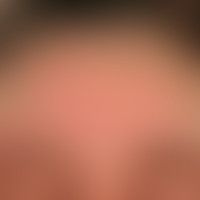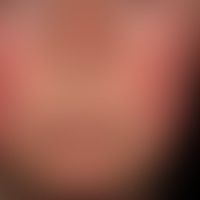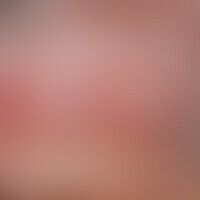Image diagnoses for "Plaque (raised surface > 1cm)", "Face"
111 results with 280 images
Results forPlaque (raised surface > 1cm)Face

Atopic dermatitis (overview) L20.-
Eczema, atopic. chronic, recurrent, itchy red spots and slightly raised red plaques on the cheeks and forehead of an 8-month-old girl; multiple, disseminated, partly crusty scratch excoriations are also visible.

Lupus erythematodes chronicus discoides L93.0
lupus erythematodes chronicus discoides: already longstanding, blurred, red, butterfly-shaped red plaques. delicate scarring beginning at the bridge of the nose. no systemic autoimmune phenomena.

Atopic dermatitis (overview) L20.-
Eczema atopic in infancy: Acutely exacerbated and pyodermized atopic eczema; positive atopic FA in both parents.

Psoriasis seborrhoic type L40.8
Psoriasis seborrhoeic type: for several months constant and therapy-resistant, only slightly elevated, homogeneously filled, symmetrical, red-yellow, slightly accentuated plaques, no type I allergies detectable.

Cutaneous lupus erythematosus (overview) L93.-
Lupus erythematosus cutaneous (overview): chronic discoid lupus erythematosus. Note the coexistence of inflammatory plaques and non-inflammatory (whitish) scarring.

Airborne contact dermatitis L23.8
Airborne Contact Dermatitis (course of therapy): The 54-year-old florist noticed an increasing itching and burning of the entire facial skin, the back of the hands and wrists during a "normal" working day at lunchtime. In the evening hours, the entire facial skin was reddened over the entire surface, swollen and itching severely, so that the emergency medical service had to be consulted.

Lupus erythematosus acute-cutaneous L93.1
lupus erythematosus acute-cutaneous: symmetrical red spots, patches and plaques on the face, neck and upper trunk areas, which have been present for several weeks. typical is the perioral recess. note: lip lesion corresponds to a herpes simplex lesion.

Chronic actinic dermatitis (overview) L57.1
Dermatitis chronic actinic (type light-provoked atopic eczema). general view: Disseminated, scratched papules and plaques, nodular in places, as well as blurred, large-area, reddened, severely itching erythema on the face of a 51-year-old female patient with atopic eczema existing since birth. the skin changes can be provoked by sunlight and photopatch testing.

Seborrheic dermatitis of adults L21.9
Dermatitis, seborrheic: Chronic, therapy-resistant, psoriasiform seborrheic eczema in a 63-year-old patient; no other clinical evidence of psoriasis vulgaris.

Keratosis seborrhoeic (overview) L82
Keratosis seborrhoeic: flat, gradually growing dissected brown plaque with a slightly punched surface, known for years. no discomfort. no bleeding

Chronic actinic dermatitis (overview) L57.1
Dermatitis chronic actinic: Chronic laminar eczema reaction which is essentially limited to the exposed skin areas Typical of chronic actinic dermatitis and thus distinguishable from a toxic light reaction (type acute solar dermatitis) is the blurred transition (eczematous scattering reactions) from lesional to healthy skin.

Acne (overview) L70.0
Acne vulgaris (overview): severe clinical picture with inflammatory papules, papulo-pustules and pustules in a 17-year-old patient; increasing course of the disease since 2 years. extensive scarring beginning in the central cheek area. picture of acne vulgaris (type: acne papulo-pustulosa, grade IV). classic indication for systemic isotretinoin therapy!

Chronic actinic dermatitis (overview) L57.1
Dermatitis, chronic actinic (type actinic reticuloid). large-area, chronically dynamic, severe eczema reaction limited to UV-exposed skin areas with rough, extensive eminently itchy plaques with fine dense scaling. massive actinic elastosis (see deep rhomboidal skin field of the entire face). already after brief exposure to the sun, increase in burning itching. no history of atopy. probably caused by the intake of thiazide-containing diuretics.

Melanosis neurocutanea Q03.8
melanosis neurocutanea. multiple, sharply defined, pigmented, black spots, plaques and nodules on head, upper extremities and upper trunk. in the area of the middle and lower trunk there is a large melanocytic nevus. evidence of leptomeningeal melanosis.

Airborne contact dermatitis L23.8
Airborne Contact Dermatitis: Findings 2 years later, interim healing. Acute laminar dermatitis after exposure to pollen.

Sarcoidosis of the skin D86.3
Sarcoidosis: anular or circinear sarcoidosis, detailed view. distinct nodular structure with brown-red color. central scarred healing.








